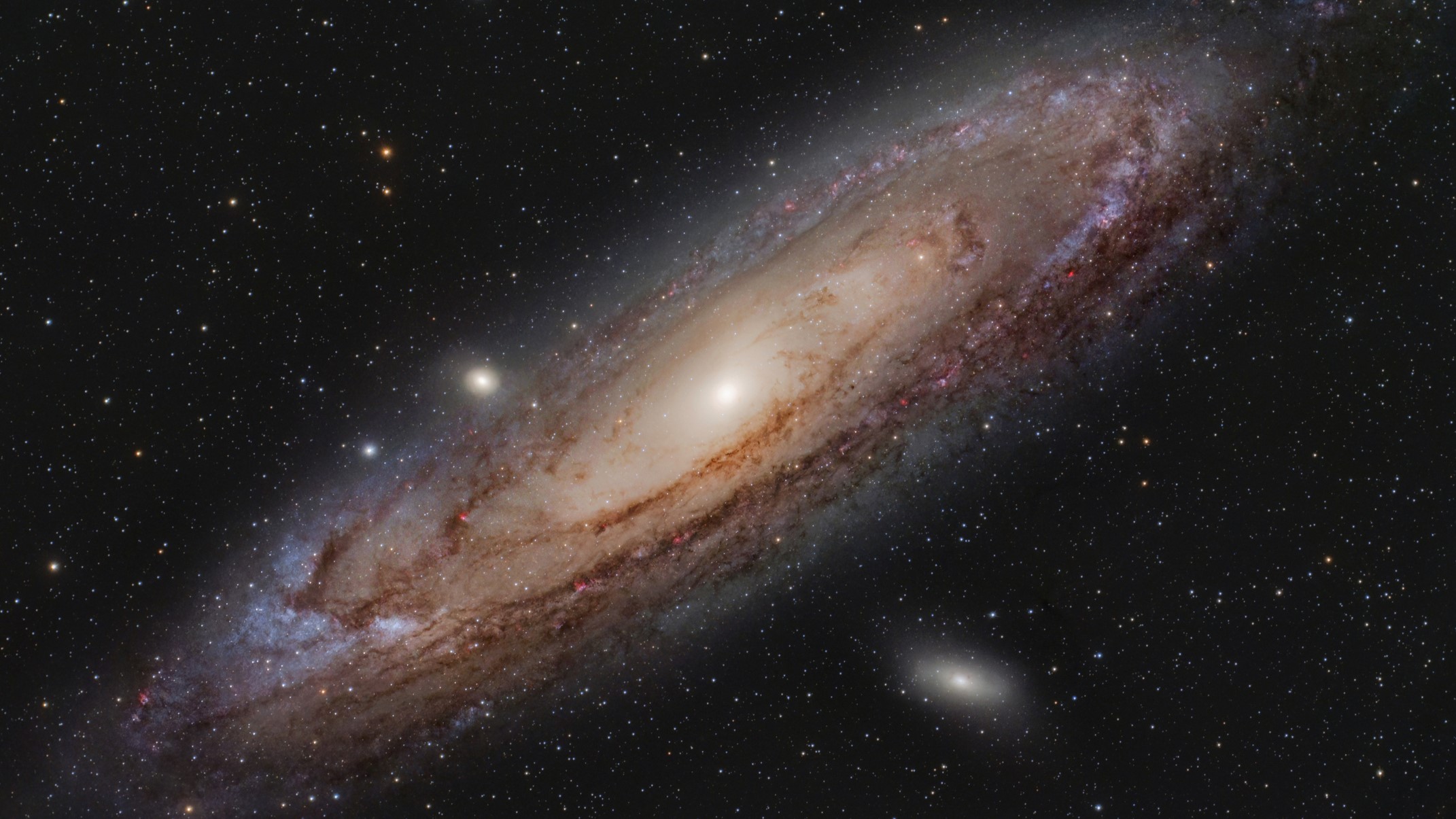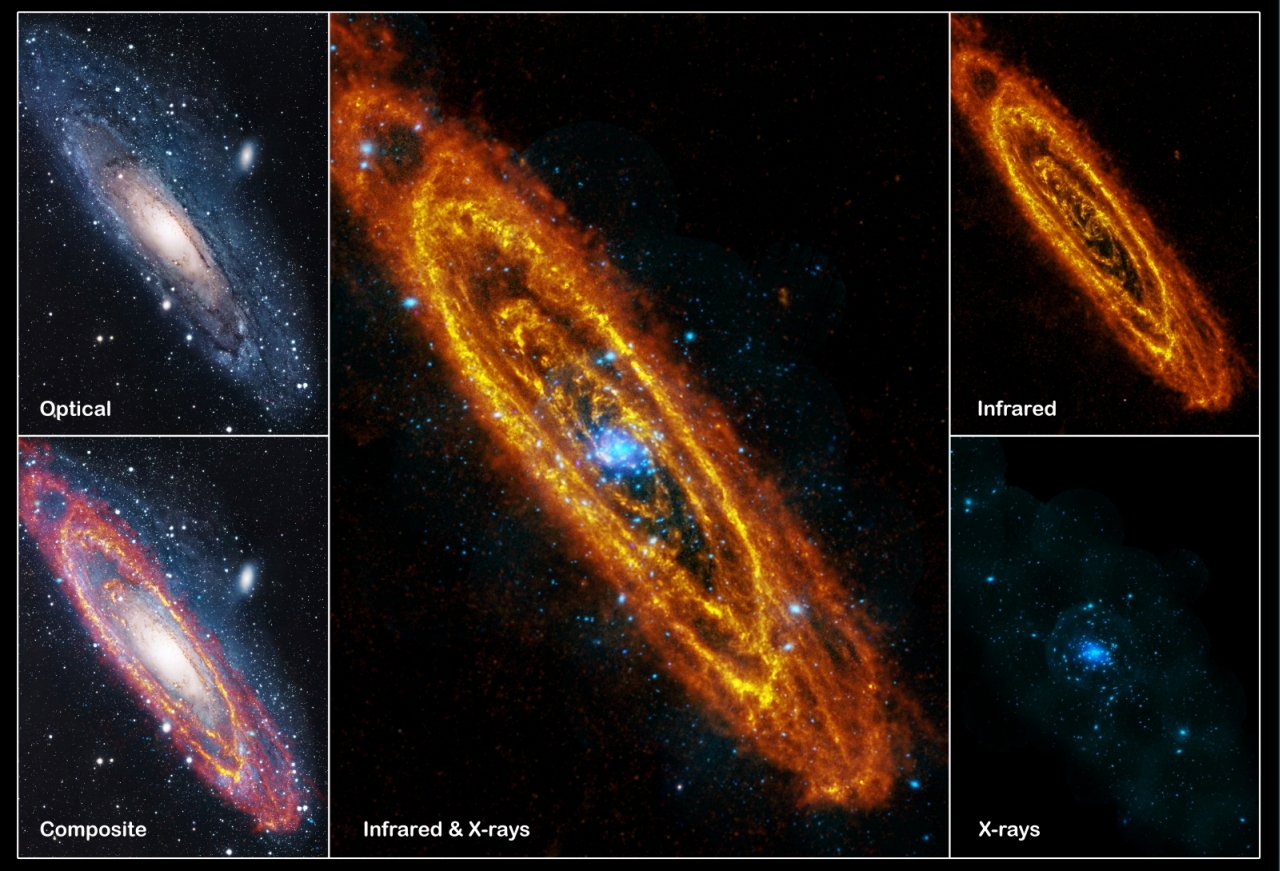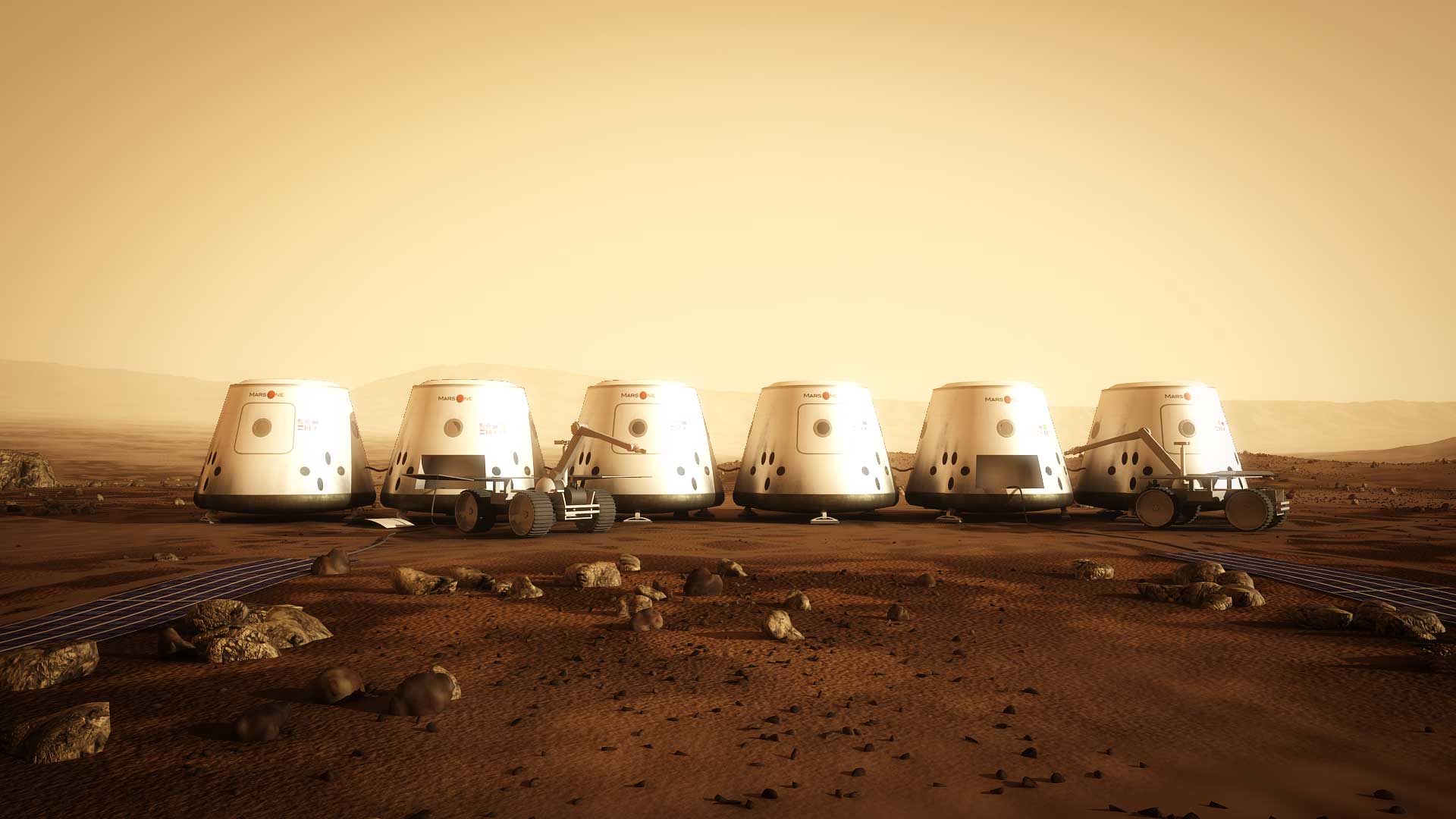Andromeda Galaxy: Facts about our closest galactic neighbor
Everything you need to know about the galaxy next door.

The Andromeda Galaxy, also called Messier 31 or M31, is the nearest major galaxy to the Milky Way.
It is 2.5 million light years away from Earth and is the other major member of the Local Group, our local collection of galaxies.
Like the Milky Way, it is a barred spiral galaxy, so-called for the bar-like structure formed by the stars in its center.
Related: Galaxies, the cosmic cities of the universe, explained by astrophysicist
Andromeda is about 260,000 light-years wide, according to NASA, making it the largest galaxy in the Local Group. However, its mass is roughly comparable to or even less than that of the Milky Way, according to NASA JPL
Scientists think the galaxy could be anywhere from 5 and 10 billion years old. However, it may not have existed in its current form until two or three billion years ago, when two smaller galaxies orbiting each other merged to form the current Andromeda Galaxy, according to a 2018 study.
How to see Andromeda in the night sky
Andromeda is visible to the naked eye but only when viewed in dark skies and ideally on a moonless night. In many places, it is visible the entire year for at least part of the night but is highest in the sky and therefore easiest to spot in August and September, according to EarthSky. There are several ways to find Andromeda. One of the easiest is to locate the constellation Cassiopeia, which forms a kind of M or W shape in the sky. The lowest point of the W is the star Schedar, which points directly at Andromeda.
Breaking space news, the latest updates on rocket launches, skywatching events and more!
Using a high-powered telescope in dark skies, it is also possible to observe some of the star clusters within the galaxy, such as the bright cluster Mayall II, also called Globular One or G1. This cluster is so bright that some researchers think it is the remnant of the core of a dwarf galaxy that merged with Andromeda in the distant past.
Related: Best telescopes 2023: For stargazing galaxies, nebulas and more
Andromeda FAQs
What will happen when we hit the Andromeda galaxy?
When the Milky Way and Andromeda merge in about 4.5 billion years, they will probably form a huge elliptical galaxy. Chances are that our solar system will be relatively unaffected. We might be pulled away from the center of the galaxy, or we might be totally ejected from it. Stars are so far apart that any sort of collision is extremely unlikely. However, it's almost certain that the increasing luminosity of our sun will have caused Earth to become inhospitable to all multicellular life by this point, so we will not be around to find out.
Can you see the Andromeda galaxy from Earth?
You can see Andromeda from Earth even without a telescope in dark skies. An easy way to find it is to locate the "W" shape of the constellation Cassiopeia, which points towards Andromeda.
Is Andromeda bigger than the Milky Way?
Andromeda is larger than the Milky Way in terms of the distance it extends. However, the two galaxies are roughly comparable in mass, and it's hard to say which one is more massive.
Colliding galaxies
Andromeda and the Milky Way are slowly drifting towards each other, leading scientists to conclude that they will likely collide about 4.5 billion years from now, according to a 2019 study. The two galaxies will most likely form a giant elliptical, or oval, galaxy, according to NASA.
It's not clear what might happen to our planet and solar system during this merger. Scientists think we might be swept about much further away from the core of the Milky Way, according to NASA, or be completely ejected from our galaxy. However, neither one of these things would greatly impact our solar system.
Unfortunately (or fortunately) for us, we will almost definitely not be around to find out what happens. By around a billion years from now, the sun's increasing luminosity is predicted to have disrupted life on Earth so thoroughly that only single-celled organisms will be left.
A possible exoplanet
In 1999, scientists noticed a minute change in Andromeda known as a microlensing event, which they called PA-99-N2. Gravitational lensing happens when something extremely massive, like a large galaxy, bends the light of a far more distant background object behind it, sometimes creating multiple distorted images of that object. With microlensing, a smaller object, like a star or planet, causes this type of distortion. The distortion of light causes the background source to become temporarily brighter, according to the Planetary Society.
One explanation for this event is that the background object was a red giant star in Andromeda, and the lensing object was another star in the galaxy, possibly with a planet orbiting it. Scientists think this star has a planet because of the pattern of the brightening during the event. If this planet exists, it would be the first exoplanet discovered in another galaxy. The planet may be around 6.34 times the mass of Jupiter, according to a 2012 study.
Andromeda and the Great Debate
In the 1920s, the distant galaxy became part of the Great Debate between American astronomers Harlow Shapley and Heber Curtis. At the time, astronomers thought the Milky Way composed the whole universe, and the strange patches such as Andromeda (known as "nebulas" at the time) lay inside of them. Curtis had spotted various novas in Andromeda and argued it was not a "nebula" but instead that it was a separate galaxy.
The discussion wasn't concluded until 1925 when Edwin Hubble identified a special kind of star known as a Cepheid variable — a star whose characteristics allow for precise measurements of distance — within Andromeda. Because Shapley had previously determined that the Milky Way was only 100,000 light-years across, Hubble's calculations revealed that the fuzzy patch was too far away to lie within the Milky Way.
Andromeda expert Q&A
Virginia Trimble is an astronomer who has studied the structure and evolution of stars, galaxies, and the universe. A trailblazing female astronomer, one-time "Miss Twilight Zone," and former annual chronicler of astronomy research, her current work focuses on the history of science and on scientometrics, the study of the scientific literature.
What are some major similarities and differences between Andromeda and our Milky Way galaxy?
Both are intermediate-type spirals, probably with 3-D central bars (not very strong ones). M31 is often reported as somewhat more massive. Both central black holes are fairly inactive (M31 is even less active than the Milky Way at least at present).
M31 probably has more globular clusters. Both have families of a dozen or more dwarf galaxies around them, the Milky Way's dwarf galaxies are better inventoried than M31 because they're easier to observe. How similar would they look if we could see both from the outside? Not quite sure, because we cannot see our own from outside!
What are some ways we think Andromeda might have evolved and changed over time?
The current understanding is that both the Milky Way and M31 (and large galaxies in general) have formed from mergers of a few smaller ones and ongoing accretion of dwarf galaxies.
The evidence is streams of stars moving together in the Milky Way that are left from such dwarfs coming close and getting torn apart. As a result, there are lots of stars in the Milky Way that are older than the age of the fully assembled galaxy. Mergers still occur from time to time for both the Milky Way and M31. Both probably also have had their nuclei more active in the past when the central black holes experienced episodes of accreting gas and/or having a star come close enough to get torn apart (tidal disruption event) and fall into the black hole.
Why do researchers think Andromeda will collide or merge with our galaxy?
The two galaxies are moving toward each other now at about 100 km/sec and are about 685,000 parsecs apart, so some interaction is inevitable. Probably a glancing collision because the Milky Way and M31 are not aimed exactly straight at one another.
How would our galaxy merging with Andromeda impact Earth and our solar system?
Not predictable for certain (because there is some tiny probability of a near collision of the sun with an M31 star) but almost certainly fairly minor because the stars are so far apart compared to their sizes and the sizes of the main part of the solar system.
Gas from the two galaxies will definitely collide, form a shock[wave] and very likely trigger an episode of star formation so that a few million years later, we would probably have lots more young, bright stars near enough to be naked-eye objects.
Addtional resources
Explore the Andromeda galaxy in incredible detail with this zoomable image from the Hubble space telescope. If you're interested in photographing the Andromeda galaxy, AstroBackyard has some useful resources on the equipment you'd need. Astronomy.com answers an interesting question "If the universe is expanding, why will the Milky Way and Andromeda galaxies collide?" in their Ask Astro article.
Bibliography
NASA. "The Galaxy Next Door," accessed October 23, 2023. https://www.nasa.gov/image-article/galaxy-next-door/
NASA Jet Propulsion Laboratory. "Cool, New Views of Andromeda Galaxy," accessed October 23, 2023. https://www.jpl.nasa.gov/news/cool-new-views-of-andromeda-galaxy
Schindler, K. "Views From Mars Hill: Andromeda Galaxy," Lowell Observatory, accessed October 23, 2023. https://lowell.edu/views-from-mars-hill-andromeda-galaxy/
Hammer F et al. "A 2–3 billion-year-old major merger paradigm for the Andromeda galaxy and its outskirts," Monthly Notices of the Royal Astronomical Society, accessed October 23, 2023. https://academic.oup.com/mnras/article/475/2/2754/4839413
McClure, B. "Andromeda galaxy: All you need to know," EarthSky, accessed October 23, 2023. https://earthsky.org/clusters-nebulae-galaxies/andromeda-galaxy-closest-spiral-to-milky-way/
Refreshing Views. "Star Clusters in Another Galaxy," accessed October 23, 2023. https://www.youtube.com/watch?v=AlTi1vbkmnA&t=443s
Ma J et al. "Structural parameters of Mayall II = G1 in M31," Monthly Notices of the Royal Astronomical Society, accessed October 23, 2023. https://academic.oup.com/mnras/article/376/4/1621/1014745?login=false
van der Marel R et al. "First Gaia Dynamics of the Andromeda System: DR2 Proper Motions, Orbits, and Rotation of M31 and M33," The Astrophysical Journal, accessed October 23, 2023. https://iopscience.iop.org/article/10.3847/1538-4357/ab001b
NASA Hubble Mission Team. "NASA's Hubble Shows Milky Way is Destined for Head-On Collision," accessed October 23, 2023." https://science.nasa.gov/missions/hubble/nasas-hubble-shows-milky-way-is-destined-for-head-on-collision/
Muir H. "Galactic merger to 'evict' Sun and Earth," New Scientist, accessed October 23, 2023. https://www.newscientist.com/article/dn11852-galactic-merger-to-evict-sun-and-earth/#.VDVdDvl_uVB
O'Malley-James, Jack T et al. "Swansong biospheres II: the final signs of life on terrestrial planets near the end of their habitable lifetimes," International Journal of Astrobiology, accessed October 23, 2023. https://www.cambridge.org/core/journals/international-journal-of-astrobiology/article/abs/swansong-biospheres-ii-the-final-signs-of-life-on-terrestrial-planets-near-the-end-of-their-habitable-lifetimes/EC5E8031028203F2EA3866C170575922
The Planetary Society. "Space-Warping Planets: The Microlensing Method," accessed October 23, 2023. https://www.planetary.org/articles/space-warping-planets-the-microlensing-method
Ingrosso, G et al. "Detection of exoplanets in M31 with Pixel-Lensing: The Event PA-99-N2 Case," The Twelfth Marcel Grossmann Meeting, accessed October 23, 2023. https://www.worldscientific.com/doi/abs/10.1142/9789814374552_0433

Nola Taylor Tillman is a contributing writer for Space.com. She loves all things space and astronomy-related, and always wants to learn more. She has a Bachelor's degree in English and Astrophysics from Agnes Scott College and served as an intern at Sky & Telescope magazine. She loves to speak to groups on astronomy-related subjects. She lives with her husband in Atlanta, Georgia. Follow her on Bluesky at @astrowriter.social.bluesky


